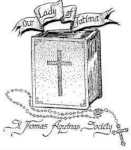St. Thomas Aquinas
St. Thomas Aquinas was born about the year 1225 at Roccasecca, Italy to Countess Theodora and to Count Landulf of Aquino. The family could claim relationship with St. Gregory the Great, St. Louis of France and St. Ferdinand of Castille. While still an infant, Thomas’ sanctity and vocaton were predicted by the holy hermit Bonus to his mother.
 Thomas’ education began at age five at the Benedictine Abbey of Monte Cassino, a few miles from Roccasecca. It was here that Thomas, who was very prayerful, studious and quiet, flourished. When he was just ten, his parents sent him to the University of Naples where he continued to advance in his studies and also in a life of holiness. Though held up to the other students for his excellence, he was well-loved because of his gentle and humble disposition.
Thomas’ education began at age five at the Benedictine Abbey of Monte Cassino, a few miles from Roccasecca. It was here that Thomas, who was very prayerful, studious and quiet, flourished. When he was just ten, his parents sent him to the University of Naples where he continued to advance in his studies and also in a life of holiness. Though held up to the other students for his excellence, he was well-loved because of his gentle and humble disposition.
While in Naples, Thomas attended a Dominican church where bright rays were witnessed pouring forth from his countenance on more than one occasion while Thomas was in prayer before God’s holy altar. Here, despite feeling unworthy of such a great grace, he joined the Dominican Order.
When Countess Theodora heard of her son’s profession, she had him kidnapped by his brothers. They kept him in captivity in the castle of Roccasecca for 15 months and tried to get him to renounce his vocation as a Dominican. They provided a temptress which they hoped would seduce him, but he grabbed a hot brand out of the fire and chased her away. Later, in answer to his prayers, the angels girded him with a miraculous card of perpetual chastity, which has merited for him the title of the “Angelic Doctor”. Rather than admit defeat, his family connived his “escape” and he was let down in a basket from the tower to awaiting friars.
 Thomas’ father, Count Landulf, had always wanted Thomas to be the Abbot of the Benedictine Abbey of Monte Cassino. He pleaded witht he Pope to make an exception so that Thomas could still hold that esteemed position. Though the Pope agreed, Thomas begged the pope’s permission to decline. Thomas’ desire was honored and the case was closed permanently.
Thomas’ father, Count Landulf, had always wanted Thomas to be the Abbot of the Benedictine Abbey of Monte Cassino. He pleaded witht he Pope to make an exception so that Thomas could still hold that esteemed position. Though the Pope agreed, Thomas begged the pope’s permission to decline. Thomas’ desire was honored and the case was closed permanently.
Later, in Cologne, Thomas became a disciple of St. Albert the Great. Because of Thomas’ humility and quiet disposition, he was labeled the Dumb Ox. A fellow student “helpfully” tutored Thomas. One day when the student did not know the answer, he heard Thomas’ explanation. From that point forward, Thomas’ true genius and love of the truth was known.
In 1245 Thomas went with St. Albert to Paris where he met a young Franciscan named Bonaventure. They became great friends. Both received a Bachelor’s of Theology in 1248. Thomas and St. Albert returned to Cologne that same year. Thomas was ordained a priest and began teaching.
In 1252 Thomas returned to Paris and was so successful as a teacher that he was ordered to attain the degree of Doctor. A bitter dispute arose between the friars and secular doctors. Thomas’ eloquent defense saved the mendicant Orders from destruction. It took a papal bull to readmit Thomas and Bonaventure to their theological chairs on the university staff.
Thomas taught in Rome at the schools attached to the Papal Court. In 1269 Thomas defended the Holy Eucharist, and as witnessed by the sacristan of the the priory, Brother Dominic, the paper was confirmed by the Lord Himself; “Thomas, thou hast written well concerning the Sacrament of my Body.” In 1272 Thomas returned to Naples to teach.
Thomas taught the compatibility of reason and revealed truth. He wrote many works and is particularly know for his Summa Theologica which remains a basis of Catholic Faith and is quoted throughout the Catechism of the Catholic Church.
Thomas wrote a number of prayers including the Adoro Te and is credited with writing the Anima Christi: Soul of Christ, sanctify me… Thomas was instrumental in the proclamation of the Feast of Corpus Christi and wrote the office for that feast. Finally, Thomas’ hymns “O Salutaris” and “Tantum Ergo” are well known and have been sung throughout the centuries.
Onn his way to the second Council of Lyons, ordered there by Gregory X, Thomas fell sick and died at the Cistercian monastery of Fossa Nuova on March 7, 1274. St. Thomas Aquinas was one of the greatest and most influential theologians of all time. He was canonized in 1323 and declared Doctor of the Church by Pope Pius V. His memorial is celebrated on January 28th.

